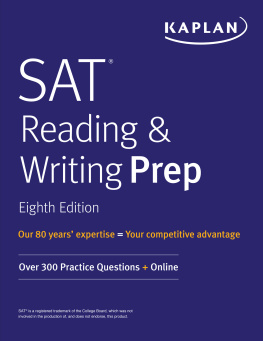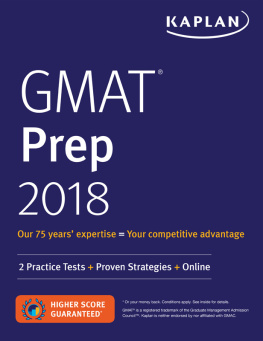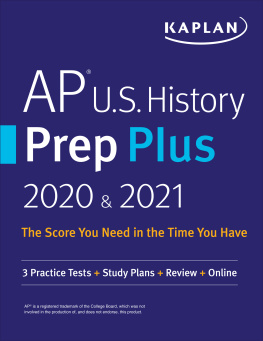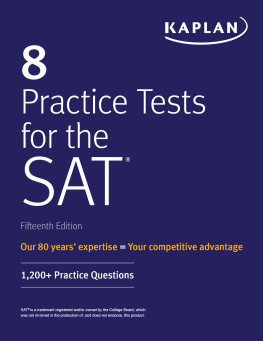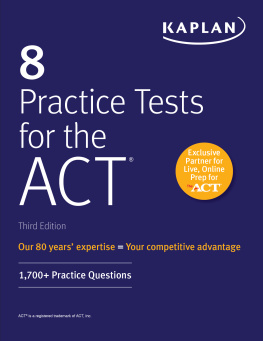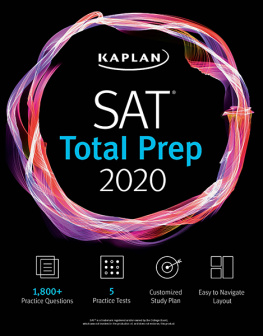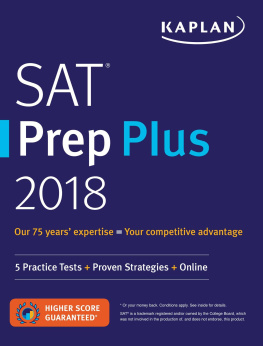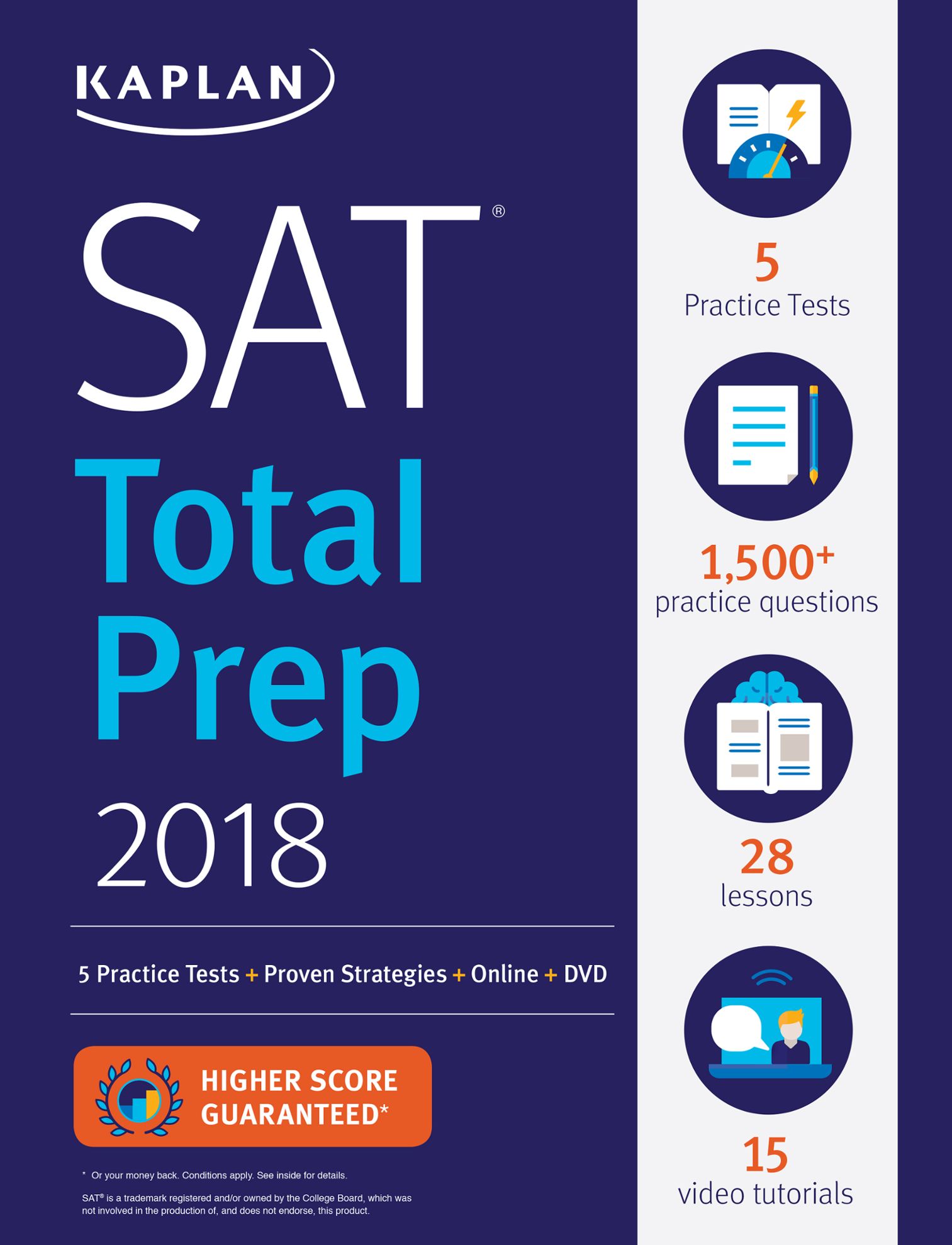
SAT: Total Prep
2018
SAT is a trademark registered and/or owned by the College Board, which was not involved in the production of, and does not endorse, this product.
SAT is a trademark registered and/or owned by the College Board, which was not involved in the production of, anddoes not endorse, this product.
This publication is designed to provide accurate and authoritative information in regard to the subjectmatter covered. It is sold with the understanding that the publisher is not engaged in rendering legal,accounting, or other professional service. If legal advice or other expert assistance is required, the servicesof a competent professional should be sought.
2017 by Kaplan, Inc.
Published by Kaplan Publishing, a division of Kaplan, Inc.
750 Third Avenue
New York, NY 10017
All rights reserved under International and Pan-American Copyright Conventions. By payment of the required fees, you have been granted the non-exclusive, non-transferable right to access and read the text of this eBook on screen. No part of this text may be reproduced, transmitted, downloaded, decompiled, reverse engineered, or stored in or introduced into any information storage and retrieval system, in any form or by any means, whether electronic or mechanical, now known or hereinafter invented, without the express written permission of the publisher.
ISBN-13: 978-1-5062-2135-9
Introduction to the SAT
The first step to achieving SAT success is to learn about the structure of the test and why its so important for your future. The SAT, like any standardized test, is predictable. The more comfortable you are with the test structure, the more confidently you will approach each question type, thus maximizing your score.
SAT STRUCTURE
The SAT is 3 hours long, or 3 hours and 50 minutes long if you choose to complete the optional Essay Test. It is made up of mostly multiple-choice questions that test two subject areas: Math and Evidence-Based Reading and Writing. The latter is broken into a Reading Test and a Writing & Language Test.
| Test | Allotted Time (min.) | Question Count |
|---|
| Reading | 65 | 52 |
| Writing & Language | 35 | 44 |
| Math | 80 | 58 |
| Essay (optional) | 50 | 1 |
| Total | 180 OR 230 (w/essay) | 154 OR 155 (w/essay) |
SAT SCORING
SAT scoring can be pretty complex. You will receive one score ranging from 200 to 800 for Evidence-Based Reading and Writing and another for Math. Your overall SAT score will range from 400 to 1600 and is calculated by adding these two scores together. You will receive a separate score for the Essay Test, if you choose to take it.
In addition to your overall scores, you will receive subscores that provide a deeper analysis of your SAT performance. The SAT also gives you a percentile ranking, which allows you to compare your scores with those of other high school students who took the test. For example, a student with a percentile of 63 has earned a score better than 63 percent of test takers.
WHERE AND WHEN TO TAKE THE SAT
The SAT is offered every year on multiple Saturday test dates. Typically, exams are offered in October, November, December, January, March, May, and June. You can take the SAT multiple times. Some states offer special administrations of the SAT on different dates. Sunday tests are available by request for students requiring religious or other exemptions. The SAT is administered at high schools around the country that serve as testing centers. Your high school may or may not be a testing center. Check www.collegeboard.org for a list of testing centers near you. Note that you must register for the SAT approximately one month in advance to avoid paying a late fee. Some SAT test dates also offer SAT Subject Tests. You may not take both the SAT and the Subject Tests in a single sitting.
THE SAT MATH TEST
The SAT Math Test is broken down into a calculator section and a no-calculator section. Questions across the sections consist of multiple-choice, student-produced response (Grid-in), and more comprehensive multi-part question sets.
| Calculator Section | No-Calculator Section | Total |
|---|
| Duration (minutes) | 55 | 25 | 80 |
| Multiple-choice | 30 | 15 | 45 |
| Grid-in | 8 | 5 | 13 |
| Total Questions | 38 | 20 | 58 |
The SAT Math Test is divided into four content areas: Heart of Algebra, Problem Solving and Data Analysis, Passport to Advanced Math, and Additional Topics in Math.
| SAT Math Test Content Area Distribution |
|---|
| Heart of Algebra (19 questions) | Analyzing and fluently solving equations and systems of equations; creating expressions, equations, and inequalities to represent relationships between quantities and to solve problems; rearranging and interpreting formulas |
| Problem Solving and Data Analysis (17 questions) | Creating and analyzing relationships using ratios, proportions, percentages, and units; describing relationships shown graphically; summarizing qualitative and quantitative data |
| Passport to Advanced Math (16 questions) | Rewriting expressions using their structure; creating, analyzing, and fluently solving quadratic and higher-order equations; purposefully manipulating polynomials to solve problems |
| Additional Topics in Math (6 questions) | Making area and volume calculations in context; investigating lines, angles, triangles, and circles using theorems; and working with trigonometric functions |
A few math questions might look like something youd expect to see on a science or history test. These crossover questions are designed to test your ability to use math in real-world scenarios. There are a total of 18 crossover questions that will contribute to subscores that span multiple tests. Nine of the questions will contribute to the Analysis in Science subscore, and Nine will contribute to the Analysis in History/Social Studies subscore.
THE SAT READING TEST
The SAT Reading Test will focus on your comprehension and reasoning skills when presented with challenging extended prose passages taken from a variety of content areas.
| SAT Reading Test Overview |
|---|
| Timing | 65 minutes |
| Questions | 52 passage-based multiple-choice questions |
| Passages | 4 single passages; 1 set of paired passages |
| Passage Length | 500750 words per passage or passage set |
Passages will draw from U.S. and World Literature, History/Social Studies, and Science. One set of History/Social Studies or Science passages will be paired. History/Social Studies and Science passages can also be accompanied by graphical representations of data such as charts, graphs, tables, and so on.
| Reading Test Passage Types |
|---|


